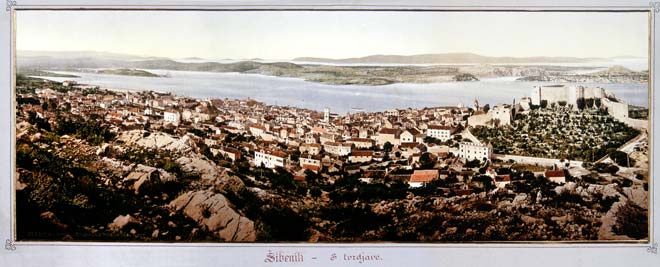Croatia in Historical Panoramic Photographs
Exhibition concept: Slavko Šterk, Miljenko Smokvina
Exhibition and poster design: Željko Kovačić

Today the concept of panorama mostly means for us an actual scene of some attractive landscape, or some striking cityspace, when we suddenly catch a glimpse of some breathtaking piece of scenery, the sight giving rise almost instantaneously to the idea that the scene needs photographic commemoration.
As explanation of what a panorama is thought was given in set design and painting much earlier than 1839 when the invention of the photograph was presented to the world. Photography understood the art's "great, spacious and broad" image in its own specific, exact, geometrical and mathematical way. A panoramic photograph is a form of presenting the surroundings with the use of all the technical and creative advantages inherent to the camera.
Before he achieved fame with the invention of the photograph, J. M. Daguerre dealt with panoramas and his invention of the diorama, a kind of stage setting that faithfully represented a landscape is very closely connected with his later invention of the daguerreotype.
A photograph that covers a very wide view of the landscape or the interior of some space and so on is called a panoramic shot. Such photographs are almost always photographs that cover a view with a much wider angle of vision than is obtained with a normal lens, which ranges from 40 to 50 degrees. Some definitions say that this is a kind of photograph with an angle of vision of at least 100 degrees. Panoramic photographs accordingly tend to be long and narrow.
In its creative and technical form of expression the panoramic photograph is unique, enabling us in a single view to obtain a glimpse of a scene that we are incapable, because of the physiological constraints imposed by the eye, of comprehending with a single look of our own eye. The simplest and most common panoramas are taken with an ordinary camera and a regular lens. They are taken in such a way that the camera turns in a horizontal plane and a panorama is exposed in several parts, the photography thus taken being stiched at the end into a whole. Such photographs were taken at the earliest times of the art. One of the inventors of the photograph, Fox Talbot, shot the first several-part panoramic calotype in 1843, and other photographers worldwide were soon taking panoramic calotypes and daguerreotypes.
The first to take panoramic shots in Croatia was an amateur of the art, the Franciscan Dragutin Parčić, who before 1862 took two-part and five-part calotype views of the village of Preko on the island of Ugljan.
Panoramic photographs can also be taken with cameras fitted with a lens with a very wide angle. Wide-angle lenses started to be made around 1860, and were later perfected so that their angle of view is from 90 to 140 degrees or even more. Shots with such cameras and lenses were used by the photograph being produced in the form of a panoramic view, the print being a long and narrow excerpt of the original negative.
Today' s modern technique of taking digital photographs has simplified panoramic photography greatly and lent it new life. This new modern "film" and "magic mirror" of contemporary cameras, the CCD, has opened up new abilities for taking panoramas, for the shots can be put together with no visible lines of discontinuity. With the use of simple add-ons and suitable applications, panoramas can also be animated, and it is hard to guess what new miracles digital or some other even more advanced photographic future will bring us.
Numerous famous and highly proficient photographers have tried out their hand at taking panoramic photos. We might mention a few of the most important Croatian and world photographers who have come to take gorgeous views of Croatia. In the 19th century, the Alinari brothers of Florence shot views of Dalmatia, Alois Beer, an Austrian from Klagenfurt, took pictures all along the coast of the Adriatic. The firms Photoglobe of Zurich and Stengel & Markert of Dresden sent the best photographers they had, whose names remain unknown however, to photograph panoramas the length and breadth of the country. As for photographers born and brought up in the country, every city or area had its own experts who were adept in taking panoramic photographs. In Zagreb there were Julius Hühn, A. Ivan Standl and Ludwig Schwoiser. In Osijek, Alois Berger was at work. Rijeka was captured by Ilario Carposio and G. Petricich, in Zadar there was Tomaso Burato and in Split there were Petar Zink and Luciano Morpurgo; Dubrovnik had Franz Laforest and J. Tošović. Ćiril Metod Iveković shot panoramas all around Croatia, though mostly along the Adriatic.
Slavko Šterk
Here are some exhibits

Zagreb

Osijek

Rovinj

Senj

Rab

Šibenik

Trogir

Split

Dubrovnik
 Exhibition catalogue
Exhibition catalogue
Šterk, Slavko. Hrvatska na povijesnim panoramskim fotografijama = Croatia in historical panoramic photographs.
Zagreb : Zagreb City Museum, 2014

